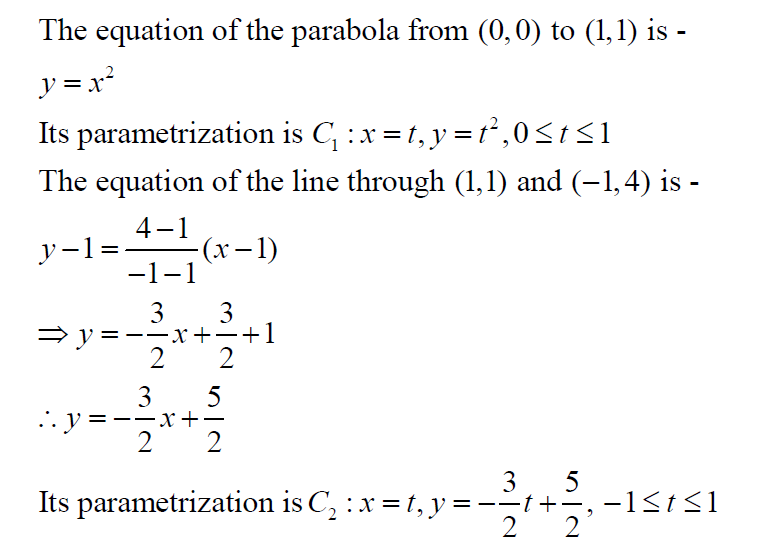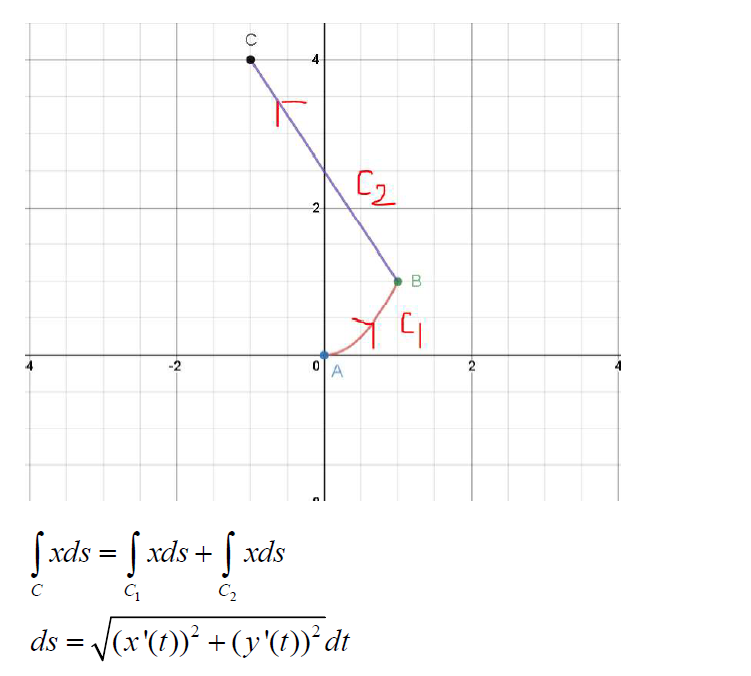Compute each of the following line integrals. (a) a ds, where C is the portion of the parabola from (0,0) to (1, 1), followed by the line segment from (1, 1) to (–1, 4).
Compute each of the following line integrals. (a) a ds, where C is the portion of the parabola from (0,0) to (1, 1), followed by the line segment from (1, 1) to (–1, 4).
Advanced Engineering Mathematics
10th Edition
ISBN:9780470458365
Author:Erwin Kreyszig
Publisher:Erwin Kreyszig
Chapter2: Second-order Linear Odes
Section: Chapter Questions
Problem 1RQ
Related questions
Topic Video
Question
100%
7_a. This question was asked before and the answer was given. (Please see the attached which has partial answer). In the given answer C_1 is considered as a line but the question says it is part of the parabola opening up. So my question is shouldn't C-1 should be y=X^2 since it is part of the parabola?
Please take a look at it and give some good explanation so that I can understand this problem. Thank you.

Transcribed Image Text:Compute each of the following line integrals.
(a)
x ds, where C is the portion of the parabola from (0,0) to (1, 1), followed by the
line segment from (1, 1) to (-1, 4).
The parabola opens upward.

Transcribed Image Text:Step 1
We have to find the value of oxds where Cis the portion of the parabola from (0, 0) to
(1, 1),followed by the line segment from (1, 1) to (-1,4)
This can be solved by the formula,
Ses (x, y. z)ds = [" f (x (1), y (1), z (1) /(x (1)² + (v (1)° + (2 (1)* )dt
→ ScS (x, y)ds = L, f (x (1), y (1) /œ (1)° + v° (1)°²dt
Sef (x, y, z)ds = [c, f (x, y, z)ds + fc,f (x, y, z)ds + ... + Sc,ƒ (x, y, z)ds
%3D
where C = C U C2 U ... Cn
Step 2
Now C'is as given in the figure:
(-1,4
C2
(1,1)
C1
(0,0)
Expert Solution
Step 1

Step 2

Step 3

Step by step
Solved in 5 steps with 5 images

Knowledge Booster
Learn more about
Need a deep-dive on the concept behind this application? Look no further. Learn more about this topic, advanced-math and related others by exploring similar questions and additional content below.Recommended textbooks for you

Advanced Engineering Mathematics
Advanced Math
ISBN:
9780470458365
Author:
Erwin Kreyszig
Publisher:
Wiley, John & Sons, Incorporated

Numerical Methods for Engineers
Advanced Math
ISBN:
9780073397924
Author:
Steven C. Chapra Dr., Raymond P. Canale
Publisher:
McGraw-Hill Education

Introductory Mathematics for Engineering Applicat…
Advanced Math
ISBN:
9781118141809
Author:
Nathan Klingbeil
Publisher:
WILEY

Advanced Engineering Mathematics
Advanced Math
ISBN:
9780470458365
Author:
Erwin Kreyszig
Publisher:
Wiley, John & Sons, Incorporated

Numerical Methods for Engineers
Advanced Math
ISBN:
9780073397924
Author:
Steven C. Chapra Dr., Raymond P. Canale
Publisher:
McGraw-Hill Education

Introductory Mathematics for Engineering Applicat…
Advanced Math
ISBN:
9781118141809
Author:
Nathan Klingbeil
Publisher:
WILEY

Mathematics For Machine Technology
Advanced Math
ISBN:
9781337798310
Author:
Peterson, John.
Publisher:
Cengage Learning,

